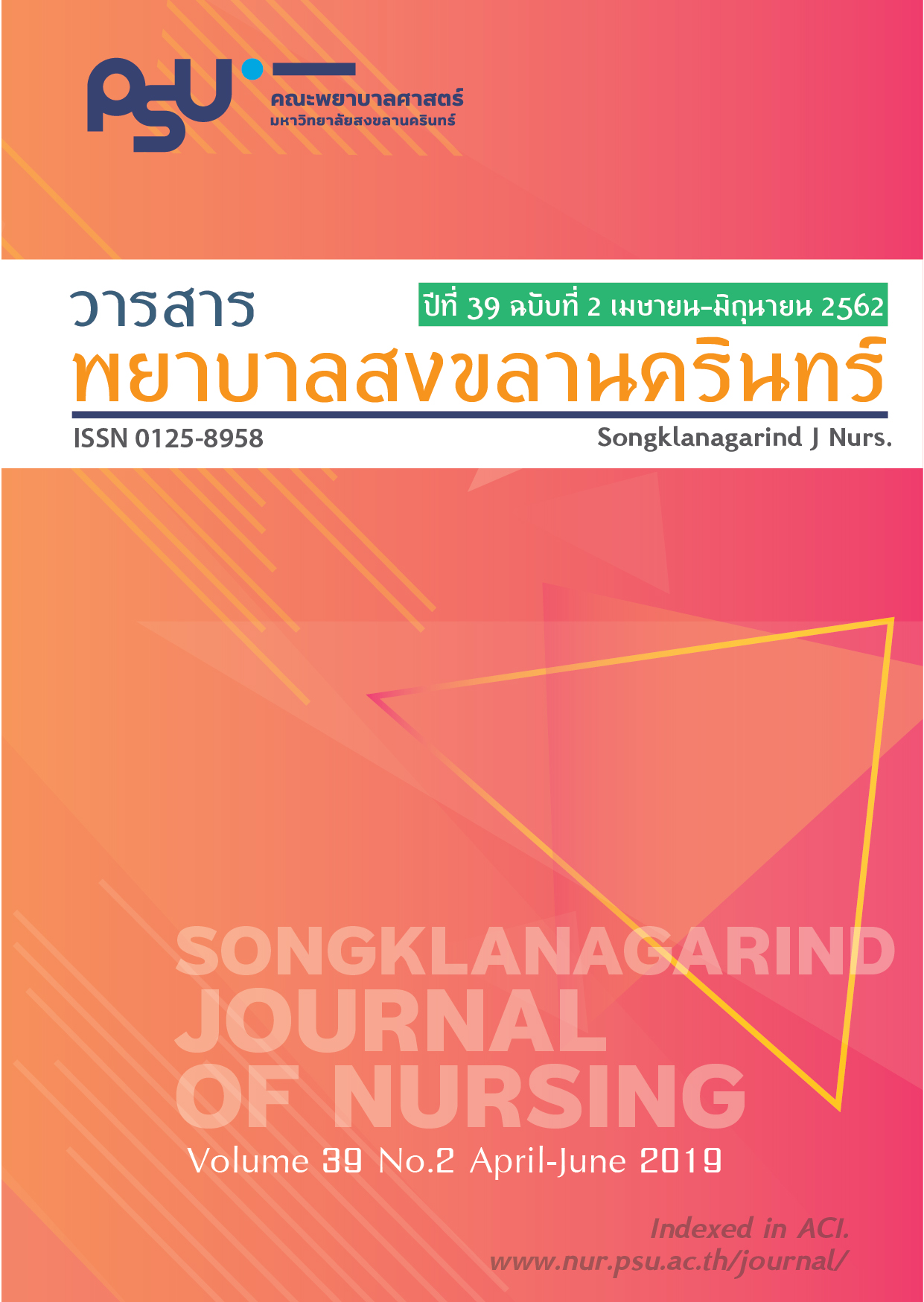ความสัมพันธ์ระหว่างระดับการทดแทนสารน้ำทางหลอดเลือดดำกับการเกิดความผิดปกติ การแข็งตัวของเลือดและการเสียชีวิตในผู้บาดเจ็บที่มีภาวะช็อก
Main Article Content
บทคัดย่อ
การวิจัยนี้เป็นการศึกษาแบบย้อนหลัง เพื่อหาความสัมพันธ์ระหว่างระดับการทดแทนสารน้ำทางหลอดเลือดดำกับการเกิดความผิดปกติการแข็งตัวของเลือดในผู้บาดเจ็บที่มีภาวะช็อก โดยศึกษาข้อมูลย้อนหลังจากเวชระเบียนของผู้บาดเจ็บที่เข้ารับการรักษาในโรงพยาบาลสุราษฎร์ธานี ระหว่างวันที่ 1 มกราคม 2559 ถึง 31 ธันวาคม 2559 จำนวน 7,023 ราย ซึ่งมีกลุ่มตัวอย่างตามเกณฑ์คัดเข้า จำนวน 326 ราย เครื่องมือวิจัยใช้แบบบันทึกปริมาณสารน้ำที่ได้รับการทดแทนทางหลอดเลือดดำ และผลการตรวจทางห้องปฏิบัติการที่เกี่ยวข้องกับการแข็งตัวของเลือด เกณฑ์ระบุความผิดปกติการแข็งตัวของเลือด ได้แก่ จำนวนเกล็ดเลือด<100,000 /uL และ/หรือ prothrombin time (PT) >13.3 วินาที และ/หรือ activated partial thrombo plastin time (aPTT) >60 วินาที และ/หรือ international normalized ratio (INR) >1.2 วิเคราะห์ข้อมูลโดยใช้ค่าสถิติความถี่ ร้อยละ ค่าเฉลี่ย ส่วนเบี่ยงเบนมาตรฐานและไคสแควร์ การวิจัยนี้เป็นการศึกษาแบบย้อนหลัง เพื่อหาความสัมพันธ์ระหว่างระดับการทดแทนสารน้ำทางหลอดเลือดดำกับการเกิดความผิดปกติการแข็งตัวของเลือดในผู้บาดเจ็บที่มีภาวะช็อก โดยศึกษาข้อมูลย้อนหลังจากเวชระเบียนของผู้บาดเจ็บที่เข้ารับการรักษาในโรงพยาบาลสุราษฎร์ธานี ระหว่างวันที่ 1 มกราคม 2559 ถึง 31 ธันวาคม 2559 จำนวน 7,023 ราย ซึ่งมีกลุ่มตัวอย่างตามเกณฑ์คัดเข้า จำนวน 326 ราย เครื่องมือวิจัยใช้แบบบันทึกปริมาณสารน้ำที่ได้รับการทดแทนทางหลอดเลือดดำ และผลการตรวจทางห้องปฏิบัติการที่เกี่ยวข้องกับการแข็งตัวของเลือด เกณฑ์ระบุความผิดปกติการแข็งตัวของเลือด ได้แก่ จำนวนเกล็ดเลือด<100,000 /uL และ/หรือ prothrombin time (PT) >13.3 วินาที และ/หรือ activated partial thrombo plastin time (aPTT) >60 วินาที และ/หรือ international normalized ratio (INR) >1.2 วิเคราะห์ข้อมูลโดยใช้ค่าสถิติความถี่ ร้อยละ ค่าเฉลี่ย ส่วนเบี่ยงเบนมาตรฐานและไคสแควร์
ผลการศึกษาพบว่า ผู้บาดเจ็บที่มีภาวะช็อกเป็นเพศชาย ร้อยละ 75.5 (n=246) มีอายุระหว่าง 15-82 ปี อายุเฉลี่ย 34.84 ปี (SD=15.41) ไม่มีโรคประจำตัว ร้อยละ 95.8 (n=312) ผู้บาดเจ็บทุกรายไม่มีประวัติการใช้ยาหรือสารที่มีผลต่อการแข็งตัวของเลือด ได้รับการส่งต่อจากโรงพยาบาลชุมชน ร้อยละ 99.7 (n=325) ผู้บาดเจ็บมีความผิดปกติการแข็งตัวของเลือดร้อยละ 44.2 (n=144) เมื่อวิเคราะห์ความสัมพันธ์ พบว่า การทดแทนสารน้ำทางหลอดเลือดดำมีความสัมพันธ์กับการเกิดความผิดปกติการแข็งตัวของเลือด (χ2=57.27, p= .000) และการเสียชีวิต (χ2=45.70, p= .000) ในผู้ป่วยบาดเจ็บที่มีภาวะช็อก
Article Details
เอกสารอ้างอิง
Wafaisade A, Wutzler S, Lefering R, et al. Drivers of acute coagulopathy after sever trauma: A multivariate analysis of 1987 patients. Emerg Med J. 2010; 27: 934-9. doi: 10.1136/emj.2009.088484.
Ruzi C, Andresen M. Treatment of acute coagulopathy associated with trauma. ISRN Crit Care. 2013; 201: 1-7.
Maegele M, Lefering R, Yucel N, Tjardes T, Rixen D, Paffrath T, et al. Early coagulopathy in multiple injury: An analysis from the German Trauma Registry on 8724 patients. Injury. 2007; 38: 298-304. doi: 10.1016/j.injury.2006.10.003
Cheddie S, Muckart DJ, Hardcastle TC. Base deficit as an early marker of coagulopathy in trauma. S Afr J Surg. 2013; 51(3): 88-90. doi: 10.7196/sajs.1665.
Sakellaris G, Blevrakis E, Petrakis I, Dimopoulou A, Dede O, Partalis N, et al. Acute coagulopathy in children with multiple trauma: A retrospective study. J Emerg Med. 2014; 47(5): 539-45. doi: 10.1016/j.jemermed.2014.06.018
Kunio NR, Differding JA, Watson KM, Stucke RS, Schreiber MA. Thrombelastography-identified coagulopathy is associated with increased morbidity and mortality after traumatic brain injury. UK J Surg 2012; 203(5): 584-8.
Jacob CM, & Kumar P. The challenge in management of hemorrhagic shock in trauma. Med J AFI. 2014; 70: 163-9.
American College of Surgeons Committee on Trauma. Advanced trauma life support (ATLS) student course manual 9th edition. USA: The Bern Convention and the Uniform Copyright Convention; 2012.
Maegele M, Paffrath T, Bouillon B. Acute traumatic coagulopathy in severe injury. Dtsch Arztebl Int. 2011; 108(49): 827-35.
Gaunt C & Woolley T. Management of haemorrhage in major trauma. Cont Educat in Anaes, Crit Care & Pain. 2014; 14(6): 251-5.
Leenen M, Scholz A, LeferingR, Flohe S. Limited volume resuscitation in hypotensive elderly multiple trauma is safe and prevents early clinic dilutive coagulopathy-a matched pair analysis from Trauma Register of the German Trauma Society. Inj Int J. 2014; 45S: S59-63.
Hussmann B, Lefering R, Waydhas C, et al. Dose increased prehospital replacement volume lead to a poor clinical course and increased mortality? A matched-pair analysis of 1896 patients of the Trauma Registry of the German Society for Trauma Surgery
who were managed by an emergency doctor at the accident site. Injury. 2013; 44: 611-7. doi: 10.1016/j.injury. 2012.02.004
Shaz BH, Winkler AM, James AB, et al. Pathophysiology of early trauma induced coagulopathy: Emerging evidence for hemodilusion and coagulation factor depletion. J Trauma. 2011; 70 (6): 1401-7.
Ministry of Public Health. Public health statistics A.D. Nonthaburi: Ministry of Public Health; 2016.
MacLeod JBA, Winkler AM, et al. Early trauma induced coagulopathy (ETIC): Prevalence across the injury spectrum. Injury, 2014; 45(5): 910-5. doi: 10.1016/j.injury.2013.11.004.
Brohi K, Singh J, Heron M, Coats T. Acute traumatic coagulopathy. J Truama. 2003; 54(6): 1127-30. doi: 10.1097/01.TA.0000069184.82147.06
Mitra B, Camerona PA, Moria A, et al. Early prediction of acute traumatic coagulopathy. Resuscitation. 2011; 82(9): 1208-13.
Johansson P I, Sorensen A M, Perner A, et al. Disseminated intravascular coagulopathy of trauma shock early after trauma? An observational study. Critical Care. 2011; 15: 1-10.


